1. Where to Stay
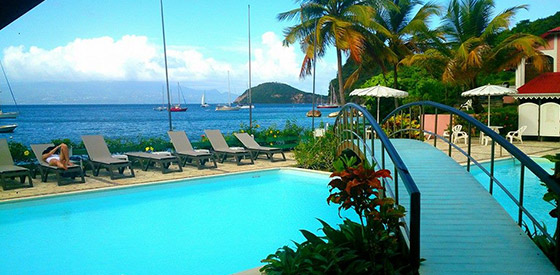
Curl up at cozyAuberge Les Petits Saints (from $212), an antique-filled private home turned guesthouse. Perched among the green hills of a quiet residential area, the inn is an oasis of lush coconut and mango trees, cheerful lime and orange walls, and killer bay views. Bask in the sun on the decked pool’s wicker chairs, or cool off in the exotically decorated living room nearby, amid leopard-print cushions, Indonesian wood panels, and African masks. Reserve a pool-front suite—each brightly painted room offers air-conditioning, satellite TV, and a sea or hill view—and rise early to take in the infinite horizon of endless blues and passing sailboats.
Wake up to a glorious view of the bay from your seafront balcony at LôBleu Hotel (from $182). Painted peach, blue, and white and situated directly on a clean, golden beach, the ten-room hotel feels more like a remote cottage, though it’s just a stone’s throw from the action in town. What the rooms lack in size, they make up for in decor—paintings from local artists depicting vibrantly colored scenes of everyday life on the islands, above and under water. Take a dip in the bay, laze on the hotel’s chaises, or simply linger over fresh breads and fruits at breakfast on perhaps the most literally waterfront veranda on the island.
Embrace the island’s snail pace from your pink, wooden beach bungalow at Le Bois Joli (from $272). Relax poolside with a Planteur rum-punch cocktail—a blend of Guadeloupe’s Bellevue white rum, orange, and guava juice, topped with sugar-cane syrup—from the open-air snack bar. You won’t need much more than swimwear and cover-ups while staying here, especially if you opt for one of the two cottages with a kitchenette, though the onsite restaurant—set on the veranda of the main Colonial house, with panoramic island views—offers local specialties worth sampling, like the ouassous, a type of crawfish, or a boudin Créole—blood sausage.
2. Where to Eat
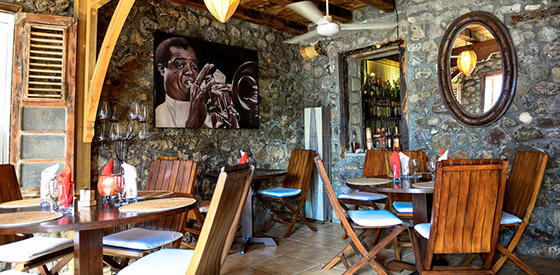
Spend an afternoon at Terre-de-Haut’s Ti Kaz’ La (“little home”) directly on the bay (10 Rue Benoit Cassin, 590-99-57-63). It’s tough to decide what’s better: the tranquil waves lapping onto the beach mere inches from your table, or the delicious and affordable three-course lunch menu. Sample rustic French bistro fare with an emphasis on the marine setting—think succulent choucroute de la mer (a spiced, seafood sauerkraut), and fresh catches like mussels and crayfish—plus indulgent desserts like warm mango soufflé with raspberry coulis (a specialty of owner-chef Philippe Dade).
Imagine you’re in a farmhouse in the South of France at Au Bon Vivre. The dimly lit, brick-and-stone-walled interior oozes warmth with its low-slung wooden chairs, antique wall mirrors, and paintings of jazz musicians, but the outside also has ambience to spare, with a cobblestone sidewalk terrace ideal for people watching. Visitors craving even more privacy can cross the main dining room to the breezy courtyard, tucked away from the street with just two tables. Chef Vincent Malbec’s French- and Caribbean-inspired menu changes daily, with dishes such as pineapple foie gras—reminiscent of his hometown, Toulouse—coconut snapper ($30), and conch lasagna ($32). End the evening with a quiet, starlit stroll by the bay, just steps from the restaurant.
End your day with few other diners in sight at Auberge Les Petits Saints. The guesthouse runs its own fine-dining establishment, where Chef Xavier Simon uses only local produce. Try the lambis a l’Asiatique ($33)—a conch chow mein with carrots and okra—the grilled lobster ($40/lb), or the day’s catch marinated in a mango-and-citrus sauce. Browse the long list of rum-infused house cocktails or just opt for the signature Ti’Punch—made from brown sugar, lime, and white rum, garnished with a sugar cane stick.
3. What to Do
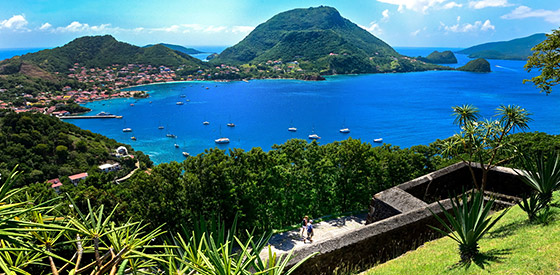
Rent a solar-powered electric car or scooter from Top-Scoot (Main Street, 590-81-49-82, $30/day; includes map and insurance)—gas-powered vehicles are prohibited on the island—for a morning of island exploration. Zoom up toward Fort Napoléon (590-99-58-60, 9 a.m.-12:30 p.m. daily, $6 adults), perched on a bluff nearly 400 feet above the bay, admiring the winding coastal views on the way. Explore the restored structure (used as a penitentiary during World War II), strolling through the manicured gardens of cactus and aloe and keeping an eye out for iguanas—bona fide island residents, you’ll glimpse them peeping out of the fort’s crevices as you roam the grounds.
Hop on Captain Gilles Meens’ catamaran (Escale Caraïbes, 690-59-02-35, $135) and sail across the UNESCO-ranked Les Saintes bay, Anse du Bourg. The eccentric French sailor turned guide knows the archipelago’s every nook and cranny. Admire the surrounding six uninhabited specks of Guadeloupe, as you pass beside giant rocks erupting out of the calm sea against a landscape of distant windmills and sailboats. Once anchored off Pain de Sucre (Sugar Loaf) Beach—“mini-Rio,” as locals call it— on Terre-de-Haut, snorkel around the sandy stretch and its rocky extremities. The waters are teeming with sergeant majors, sea urchins, and other small, bright fish. Back onboard, snack on a tourment d’amour—Les Saintes’ signature round, jam-filled tartlet (try the coconut flavor), washed down with a glass of potent rum punch.
Dive with Pisquettes (three-tank dive $184, 590-99-88-80; beginners welcome), run by a dynamic bilingual duo. You’ll likely be one of fewer than five divers at La Bombarde, an easy 40-foot dive less than ten minutes from shore. One look at the bright corals, sponges, gorgonians, angelfish, and teeming schools of boga (silver spindle-shaped fish, a common sight here, known as pisquettes in French), and it’s easy to see why Les Saintes were one of Jacques Cousteau’s favorite places to explore.
4. Insider’s Tip
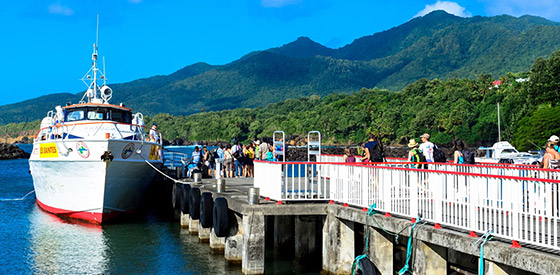
After landing at Pointe-à-Pitre International Airport, on the island of Grande-Terre (direct American Air and Seaborne flights launched last April), most tourists head to the nearby ferry terminal, Gare Maritime Internationale de Bergevin, to catch an Express-des-Iles ferry to Les Saintes, but this proves to be a longer and lackluster boat ride. Instead, catch the CTM Deher ($30 round-trip, discount for advance booking, 590-92-06-39) departing from Trois Rivières, a seaside town located on Basse-Terre. This means a smooth 45-minute drive from Pointe-à-Pitre, passing through Guadeloupe’s most verdant lands: rolling hills, sugar cane and pineapple fields, scenic fishing villages, and views of La Soufrière volcano in the distance. The last boat leaves for Terre-de-Haut at 4:30 p.m; grab a seat at the back, waterproof camera ready to capture the stunning shoreline of red-rooftop-studded hills.
5. Oddball Day
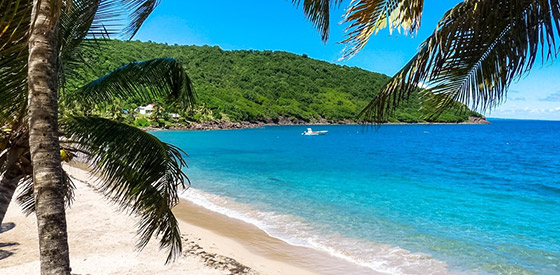
Take a break from beach bumming and venture into the verdant, hilly landscape of Les Saintes. After an early breakfast at your hotel or inn, lace up your hiking boots (and don’t forget to pack water, a hat, and sunscreen) and catch a ten-minute boat shuttle (9:30 a.m., $10 round-trip on Soleil des Iles, 690-50-36-28, tickets sold onboard) to Terre-de-Bas, “the nature island” and Les Saintes’ only other inhabited plot. Home to a littoral forest, this more sparsely populated island is an ideal place to get lost in the great outdoors. Walk first to the island’s sole beach, Grande Anse, where the hiking trail map details the two-hour Trace des Falaises hike to the top of the Morne Abyme bluff. The reward for your sweat: a breathtaking view at 700 feet of Les Saintes’ eight plots (including neighboring Dominica), plus an array of local flora and fauna like fragrant West Indian bay leaf trees, melon cacti, roaming iguanas, and a pond with sunbathing turtles. Head back down toward the beach and grab a bite at Chez Eugenette (open daily, 0590 99 81 83), a seafront Creole eatery and local favorite, serving heaping plates of rice and fresh catch ($10). Stop in at the turquoise-colored wooden shack that is Maison de l’Artisanat (Rue Dans-Fond, 590-99-80-16 or 99-65-63) and try on a piece of art on the verge of disappearance: the salako ($80), a traditional bamboo, cylinder-shaped fisherman’s hat dating back to the 19th century and found only on Terre-de-Bas. Today, two elderly resident craftsmen continue to make and sell these ingenious sun protectors (sadly, their process isn’t available for public viewing). Back on Terre-de-Haut, dine on a fresh seafood or dried-duck salad (from $13)—pick your own ingredients—or on fresh fish, smoked or curried, on the serene covered terrace at La Saladerie (Anse Mire, 590-99-53-43), towering over the bay. Rest your tired legs for the rest of the evening to the tune of Guadeloupe’s sultry zouk-love music—French Creole ballads accompanied by electric guitars and synthesized sounds—courtesy of the resident DJ at the convivial Coconuts Bar (Rue Benoit Cassin, 590-94-27-74), a colorful shack directly on Les Saintes’ bay, where locals gather to enjoy a mai tai or two (made with Guadeloupe’s renowned Rhum Boulogne) under the stars.
6. Links
The Guadeloupe Islands Tourist Board’s website is one of the few resources for English speakers on Les Saintes and the Guadeloupe Islands archipelago.
Learn more about recommended sights and restaurants on Terre-de-Haut Tourism Office’s website.
Divers will appreciate this map and footage of best dive sites around Les Saintes—no French needed.
Get a basic overview of Les Saintes and Guadeloupe Islands with this catch all holiday guide.